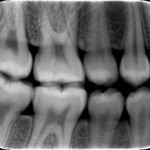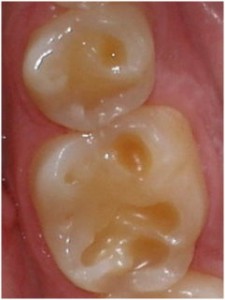 We have all had bitewing x-rays. You know, two x-rays on each side that help us detect cavities between the teeth. But, did you know that we also check for the level of your jaw bone, nerve size, margins of existing fillings and even large pieces of build up? That’s right! We get all that information from 4 little pictures.
We have all had bitewing x-rays. You know, two x-rays on each side that help us detect cavities between the teeth. But, did you know that we also check for the level of your jaw bone, nerve size, margins of existing fillings and even large pieces of build up? That’s right! We get all that information from 4 little pictures.
The guidelines we use to determine how often to take these radiographs may vary from patient to patient based on their needs. If you are at a high risk and have a history of decay or many fillings and crowns, we may choose to take bitewings twice a year. This is because early diagnostics means cheaper, easier repair. If you have a low risk or minimal history of decay and restorative work, we may choose to take your x-rays every 1.5 years instead. This is generally the longest we will wait to take x-rays in order to ensure we can diagnose abnormalities before they get out of control.
So, before you decide to forego your next x-rays, discuss the risks you may be taking, and the benefits of taking those x-rays with your dental professional. They may be able to ease your mind and answer questions you have. Just remember, fixing decay while it can repaired as a filling sure beats fixing decay after it has reached the nerve and needs a root canal!



 How do you know you have acid erosion? You or your dental provider may notice a pattern of cupping on your enamel or even enamel loss. Often times these cupped areas are mistaken for wear caused by clenching and grinding. These wear facets can put a patient at risk for cracked teeth, dental cavities, and breaking down fillings.
How do you know you have acid erosion? You or your dental provider may notice a pattern of cupping on your enamel or even enamel loss. Often times these cupped areas are mistaken for wear caused by clenching and grinding. These wear facets can put a patient at risk for cracked teeth, dental cavities, and breaking down fillings. In case you missed our e-mail blast on how to sign up for the Elmbrook Family Dental NCAA tournament, here are the details:
In case you missed our e-mail blast on how to sign up for the Elmbrook Family Dental NCAA tournament, here are the details: On March 17th each year, we celebrate the most famous Saint of Ireland with a feast and celebration. We commemorate St Patrick with parades, the color green and feasts of great food and drink! Here is a fun and simple recipe by Kraft that we found for Irish Soda bread. Enjoy!
On March 17th each year, we celebrate the most famous Saint of Ireland with a feast and celebration. We commemorate St Patrick with parades, the color green and feasts of great food and drink! Here is a fun and simple recipe by Kraft that we found for Irish Soda bread. Enjoy!